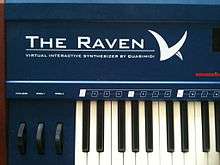Quasimidi
Quasimidi Musikelektronik GmbH was a German synthesizer manufacturer. It was founded in 1987 by Friedhelm Haas and Jörg Reichstein. It was originally based in Kirchhain, but moved to Rauschenberg in 1998. The company folded in 2000.
During the early part of its life the company produced MIDI master keyboards, and later the Quasimidi Styledrive, which could store and replay MIDI sequence and system exclusive control codes. The company also produced an upgrade kit to expand the capabilities of the popular Roland E-20 keyboard, as well as several ROM cards for the E-20 offering additional accompaniment styles.
Subsequently, they became notable for their range of synthesisers, which were aimed at the dance music market. Their first popular product was the Quasimidi Quasar, a rack-mounted digital synthesiser module which was released in 1993. The presets and drum sounds eschewed the typical General Midi specification, which was in vogue at the time, in favour of electronic and trance techno styles. The Quasar included an arpeggiator, which was an unusual feature in 1993.
Whereas the Quasar was a two-unit rackmounted box, Quasimidi's subsequent equipment was visually adventurous. Quasimidi was one of the first modern synthesizer companies to re-introduce knobs, lit buttons, and dials to synthesizer control interfaces, notably with the Quasimidi Rave-O-Lution 309 of 1997. This was a module which combined a pattern-based sequencer with a drum section and a synthesiser section. It competed in the "groovebox" market segment against Roland's popular MC-303. Quasimidi released a keyboard version of the Rave-O-Lution, as the Quasimidi Sirius, which included a built-in vocoder.
Quasimidi also built the Raven, which also was based on the dance market genre of the time, making use of a very logical sequencer which was very good for live usage, using the keys to mute or unmute elements of the tracks, and also an octave of keys allowing the sequence to be transposed in real time based on the root chord note, it also featured real and step time recording in the style of Roland type TR drum machine type step input, many Raven models were fitted with the "MAXX" expansion board which took the internal PCM data from 6 mb to 14mb, whilst the Standard Raven is quite a large palette of sounds, the MAXX version is the Raven model to own, the Raven is also similar in use to the Roland JX-305.

Quasimidi also built a master keyboard, namely the Cyber 6 which shared the same casing as the Raven, albeit a couple of cosmetic differences, most notably the striking red Livery. The Cyber 6 was a 61-note Master keyboard with aftertouch, which allowed control of 32 independent MIDI channels thanks to its two midi out sockets located on the rear, part of the advantage of this is that the keyboard can be split into zones, or layers, with each zone being able to transmit on its own MIDI channel, and can also be transposed individually in the zone, so it is possible to create large timbres using separate sound sources or synthesizers, for large thick layering on the same key zones. It also had an 8-track sequencer, in the same guise as the Raven but went beyond the realms of the traditional arpeggiator types of grooves, which became known as "Motivators", of which it featured two within the Engine of the sadly the Cyber 6 does not have any internal sounds. The Cyber 6 along with the Raven have become increasingly popular in the last few years, despite a lack of appreciation in the past or perhaps thanks to the dire manuals which were poorly translated from German to English.
Quasimidi's final product was the Polymorph, a successor of the Rave-O-Lution. Although the company's products were popular, Quasimidi went out of business in 2000.
Partial product listing
- Quasimidi Caruso (1993)
- Quasimidi Quasar (1994) synth module[1]
- Quasimidi Raven (1995) dance music synth[2]
- Quasimidi Cyber 6 (1995) master keyboard[3]
- Quasimidi Technox (1995) synth module[4]
- Quasimidi Rave-O-Lution 309 (1996) synth module/groovebox[5]
- Quasimidi Sirius (1997)
- Quasimidi Polymorph (1997)
References
- "Quasimidi Quasar". Sound on Sound. August 1994. Archived from the original on 6 June 2015.
- "Quasimidi Raven". Sound On Sound. March 1996. Archived from the original on 6 June 2015.
- "Quasimidi Cyber 6". Sound On Sound. May 1996. Archived from the original on 8 June 2015.
- "Quasimidi Technox". Sound On Sound. February 1995. Archived from the original on 6 June 2015.
- "Quasimidi Rave-O-Lution 309". Sound On Sound. May 1997. Archived from the original on 6 June 2015.
Further reading
- * Johnson, Derek. "A Sirius Matter", Sound on Sound, October 1998. Accessed 7 April 2008
- "Quasimidi Rave-O-Lution 309". Future Music. No. 57. Future Publishing. June 1997. p. 39. ISSN 0967-0378. OCLC 1032779031.
- "QuasiMIDI Quasar". Future Music. No. 22. Future Publishing. August 1994. p. 30. ISSN 0967-0378. OCLC 1032779031.
- "Quasimidi Cyber 6". Future Music. No. 41. Future Publishing. March 1996. ISSN 0967-0378. OCLC 1032779031.
- "Quasimidi Raven". Future Music. No. 42. Future Publishing. April 1996. ISSN 0967-0378. OCLC 1032779031.
- "Quasimidi Technox". Future Music. September 1996. ISSN 0967-0378. OCLC 1032779031.